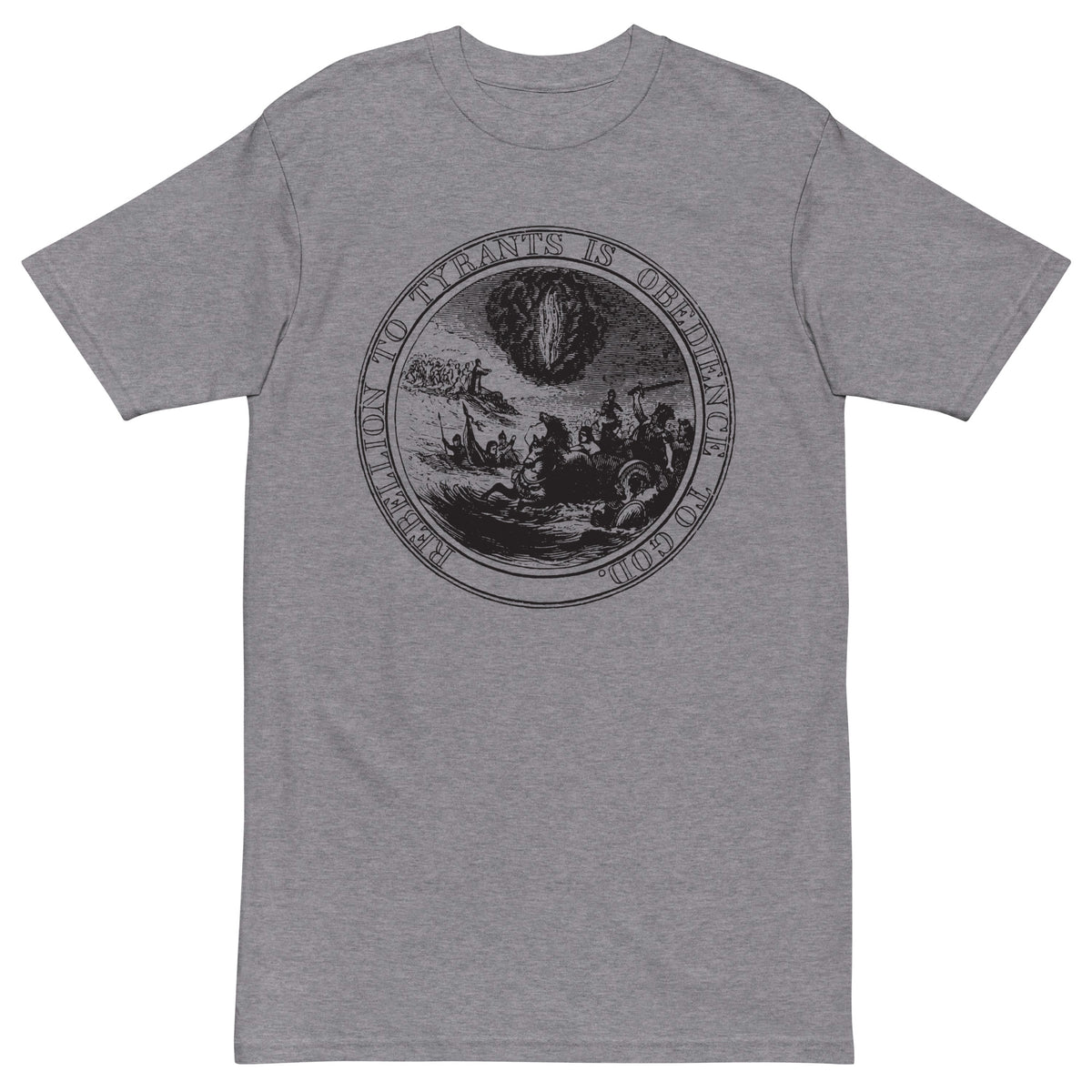











Rebellion to Tyrants is Obedience To God Franklin Motto Men’s Heavyweight Tee
In August of 1776, Benjamin Franklin explained to the committee deciding the Great Seal and other official imagery for the new nation how the great seal of America should be taken from the dramatic scene described in Exodus, where the Israelites led by Moses watch the Pharoh's men drown as the Red Sea closes in on them. This is what it looked like:

Franklin’s design was actually recommended by the first committee with some edits by Thomas Jefferson:
Pharaoh sitting in an open Chariot, a Crown on his head and a Sword in his hand, passing through the divided waters of the Red Sea in pursuit of the Israelites: Rays from a Pillar of Fire in the Cloud, expressive of the divine Presence and Command, beaming on Moses who stands on the shore and extending his hand over the Sea causes it to overwhelm Pharaoh. Motto: Rebellion to Tyrants is Obedience to God.
They thought it would be great for the reverse side of the Great Seal. In the end, however, nothing was ever sketched up and it was dropped. It wasn't until 80 years later when Benson J. Lossing decided to draw this one up for Harper’s New Monthly Magazine in July 1856 that it was ever actually realized.
The final seal became the eagle - which Franklin thought was a horrible mascot for the country. (He preferred the wild turkey.) It also sported the motto E Pluribus Unum -Out of Many, One. Charles Thomson, the well-respected Secretary of the Continental Congress was an essential, well-liked figure who was trusted with taking ideas from all the preceding committees in 1782 and blending them together. Or at least taking what they thought would be the best.
The reverse side ended up being a version of the reverse-side concept by William Barton featuring the all-seeing eye on the pyramid that to this day is connected with the idea and symbology of secret societies, Illuminati, and so on:
A Pyramid of thirteen Strata, (or Steps) Or, and, on the Summit of it a Palm Tree, proper. In the Zenith, an Eye, surrounded with a Glory, proper.
In a Scroll, above, or in the Margin –
"Deo Favente."
The Exergue – "Perennis."
Deo Favente is Latin for "with God's favor." Perennis means "everlasting" or "through years."
Thomas also created two new mottoes: "Novus Ordo Seclorum" (A New Order of the Ages) and "Annuit Coeptis" (Providence has Favored Our Undertakings). The whole thing was put to bed on June 20, 1782. The committee approved the revisions, and the seal was complete. They remain to this day.
Thomas Jefferson likewise liked the motto “Rebellion to Tyrants is Obedience to God” so much, he used it on his personal seal. Not exactly a huge surprise, as his Declaration of Independence says that we not only have the right but we also have the duty to alter or abolish any government that does not secure our unalienable rights, including life, liberty, and the pursuit of happiness.
Heavyweight tee. The tee has a structured, classy fit and is both durable and soft thanks to its ring-spun cotton material. Layer the t-shirt or wear it on its own and enjoy great looks with little effort!
• 100% combed ring-spun cotton
• Charcoal Heather and Carbon Grey is 60% cotton and 40% polyester
• Fabric weight: 6.5 oz/yd² (220 g/m²)
• 20 singles
• Regular fit
• Side-seamed construction
• 1 × 1 rib at collar
• Single-needle edge stitch 7/8″
Size guide
| S | M | L | XL | 2XL | 3XL | 4XL | |
| Width (inches) | 18 | 20 | 22 | 24 | 26 | 28 | 30 |
| Length (inches) | 29 ½ | 30 ½ | 31 ½ | 32 ½ | 33 ½ | 34 ½ | 35 ½ |
Collections: Heavyweight, Holiday Sales, Men's Apparel and Accessories, Men's Tops | Graphic Tees for Rebels & Liberty Lovers, New Arrivals, Original Typographic Tees for Free Minds, Sale | All Sale Items, Vintage Collection
Type: Mens Top
Category: america, american revolution, Ben Franklin, bible, flood, founding fathers, god, heavy, heavy weight, heavyweight, history, liberty, liberty maniacs, mens, Moses, motto, obedience, rebellion, retro, revel, sale, short sleeve, tshirt, tyrannt, verse, vintage



















